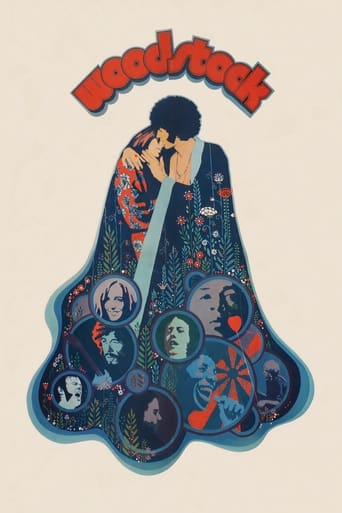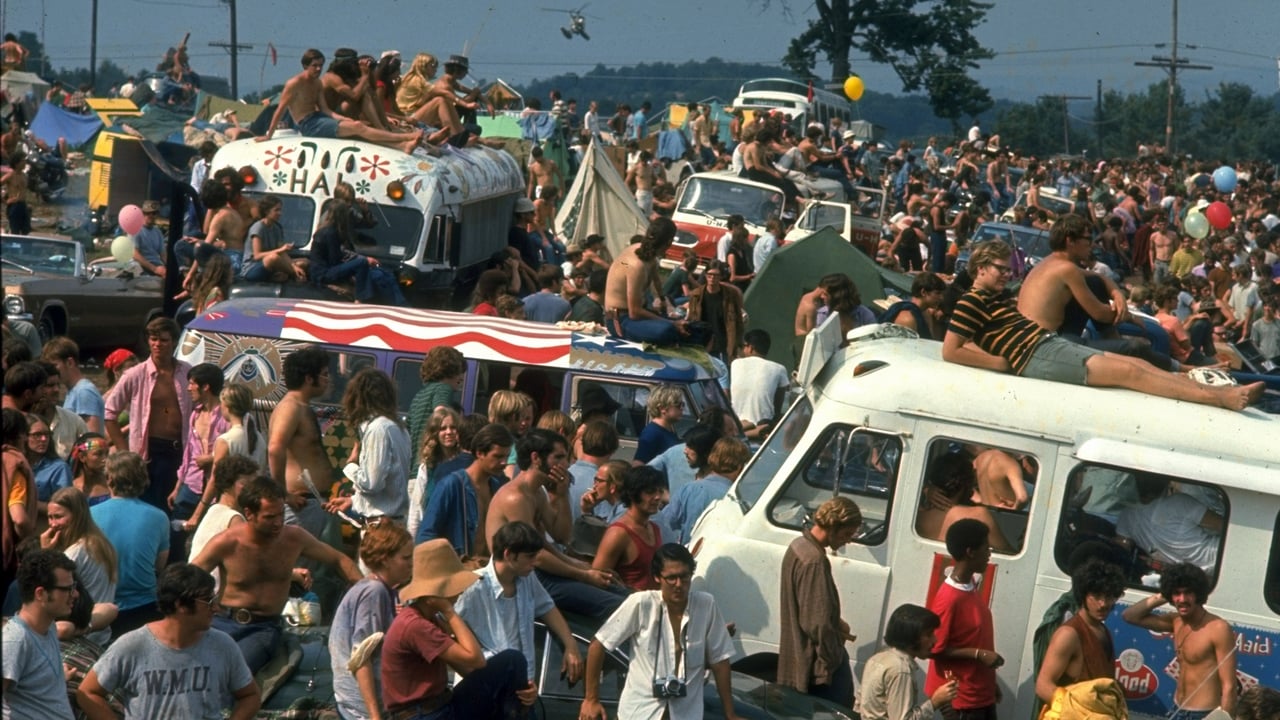SnoopyStyle
This is a documentary of the iconic 1969 three-day music festival in upstate New York. The use of the split screen is interesting. It gives the movie a sense of chaos and energy. The performances are iconic to say the least. It is a little funny to follow Sha Na Na with Joe Cocker. The cheesiness of the choreographed dancing clash decisively with the raw power of Cocker. The music is generally great, raw, and close-up. There are some other scenes like the yoga class that breaks up the movie and gives it some fun. It's also gets full marks for being a time capsule of that landmark event. It does run long but it was quite an event.
Emil Bakkum
Documentaries about musical events do not really lend themselves to a review. However Woodstock was just as much a social event as a concert. For several days the fields changed into a temporary city. It is interesting to see how Michael Wadleigh displays and interprets the attitude of the crowd. He interviews the visitors, and asks them about their motives to be there. Most of them are barely grown people. Many simply follow the flow, but for others the festival is an opportunity to increase their wisdom of life. They arrive as groups and communes, and try to learn from each others experiences. There are spiritual meetings. There is recreation and fun, like the mud slides in the rain. But there are also social experiments, like nude swimming and even public drug (ab)use. They blow to make other people interesting. They may have read about the evils of drugs, and gave up reading. The cast of singers and song groups looks impressive. But to be fair, I did not like their music then, and in the film it looks truly poor and miserable. In many cases the appearance consists of screaming and physical convulsions. Today such a performance would not attract such an enormous crowd. It takes the drummers a minute to notice that their band has stopped playing. Joke: what is the difference between an electric guitar and a chainsaw? The grip. Probably it makes more sense to interpret the festival as a demonstration against war and violence. America was in the grip of the civil rights movement. Several charismatic leaders had been murdered. And most of all, there was the appalling war in Vietnam, which threatened the future of the male youth. On stage Joan Baez tells about the objection to military service of her boyfriend. If your life expectancy is just a few years, there is some cause for screaming and wild social experiments. The right to bear arms is slightly less ludicrous than the right to arm bears. By the way, why do soldier look so tired on 1 April? Because they just had a 31-day March. Actually Woodstock was a sad event. And Wadleigh must get the credit for managing to convey this message - which is a recommendation. Don't hesitate to leave a comment. I love it.
grantss
Superb capturing of a seminal moment in musical and cultural history.A documentary on the Woodstock festival of 1969. Shows not only the music but every other aspect too: the organising, the financial implications, the effect on fans and locals and the chronology of events within the festival.Based on the music alone, this is a fantastic film: Richie Havens, Joan Baez, The Who, Sha-Na-Na, Joe Cocker (in the performance that would launch his career), Country Joe and the Fish, Crosby Stills and Nash, Ten Years After, John Sebastian, Santana, Sly and the Family Stone and Jimi Hendrix (a performance which included his famous rendition of The Star Spangled Banner).Despite the reasonable primitive conditions and often inhospitable weather, the sound and video footage is great. However, the thing that elevates this movie above the average concert movie is the footage of how things transpired and what happened behind the scenes. It is thanks to this that you get to understand the enormity and importance of the event. It also helps you understand the idealism, benevolent intentions and harmony of the concert goers and of that generation.
Dr Jacques COULARDEAU
This four DVD collection is essential: the director's cut of the film, one DVD of extra music and one DVD of interviews. This last DVD is interesting for the technical details and all the material conditions. It is anecdotal and somewhere it misses the essential point: the music – as a representative of the world – of the twentieth century has been through a revolution and Woodstock is the first demonstration (like in science and mathematics) of the total jump of the whites in America, slightly after the British and the Europeans, into endorsing that new music. To find what is so original in that new music is not that difficult today if we have followed the vast research in the whole world about music all along human history. Listen to the DVDs or to the CDs and you will find out that this music has one characteristic that unifies all the styles or nearly: it is polyrhythmic. It is so obvious that discussing the point is pointless. Back in Europe and in the 20s and 30s there had been some attempts in "classical" or "symphonic" music to produce polyrhythmia but it had failed to conquer the vast popular public. Popular music was entirely locked up in good old songs and good old monorhythmia. What is polyrhythmia that Mr. Word's Dictionary refuses? It is the fact that a superficial and traditional rhythmic line, generally binary or ternary, covers up and is articulated upon a far faster rhythmic line that can run in multiples of two or three. That faster rhythm can be carried by the modern drums (where do they come from?) or contained in the singing or in the melodious line of one particular instrument, the bass or the lead guitar used as a rhythmic accompaniment. That was invented in the United States of America and was the consequence of a social, political and geo-demographic phenomenon known as the slave trade and slavery. In Africa, music is originally polyrhythmic and the instruments they used are drums and percussions of many very different types from the tam-tam to the water drum. The slower rhythm is the one to which most people dance and the faster rhythm is magic in a way since it can lead to a trance, to vodun (or voodoo) illumination, with or without the help of alcohol or other substances. The Blacks arrived in America and kept their rhythm, their music and used it all the time in the fields. That will produce black music whose first fully developed form will be jazz. Jazz will become a hit thanks to the radio but jazz requires a new instrument, the modern drums of our bands. They more or less took all the instruments from the European tradition and just associated them so that one person could use both hands and both feet to create a rhythmic universe that was by definition polyrhythmic. From Jazz to rock and roll and modern popular music there is only about twenty to thirty years. The radio will make it popular everywhere in the world, would I say, and then television added its own two bits. The whites learned it and started producing their own, the British being ahead with the first bands that managed to move vast audiences and to spread everywhere in the world. The Americans were just going to follow that road. Woodstock is the first time in American history that such a mass of essentially white people gathered to listen to that kind of music, white, black or latino musicians together. That music is polyrhythmic and that creates a mental way of thinking that is interesting. The brain can naturally think and work along several lines at the same time, but if you make it a requirement, a style, a way of thinking it clearly implies people who are different can dance together, can mix and be together. That music is mentally, psychologically, and even psychically multiple and if two, three or four rhythms can live together why should we segregate among people any group as opposed to another, even any gender as opposed to the others. Equality in total diversity, guaranteed diversity in the very recognition of the differences of the others and the particularity of myself as not opposed, not compared but simply contrasted to the others. The world was becoming a symphony of all kinds of things and in the human sphere anything that appeared as a limit was to be gotten rid of. Even grammar for some was fascist. Good riddance. Every single particularity I decided for myself or I assume in myself became a choice and implied that I was myself and unique and that all other human beings around me were themselves and unique and that we could all live in total peace and fraternity or brotherhood or sisterhood or sorority by assuming all these differences and by letting them come to the surface of our life, to the conscience of our brains, to the reality of our existence. The First amendment became the central axle of this new world perfectly in phase and harmony with that polyrhythmic music I am talking of. In other words this polyrhythmic vision is the direct production and embodiment of that first amendment. It became the music of the people for the people by the people. We were leaving Gettysburg behind in history and making it into our flag, banner, motto, ethics. Are we conscious of what I am explaining? Of course not, otherwise I would not have to explain all that. So celebrate Woodstock as the turning point in human history that would never have been possible without the bringing of millions of black Africans to America, even if that was a crime against humanity, and without the globalization that started as soon as Auschwitz was liberated, quite a few years ago.Dr Jacques COULARDEAU, University Paris 1 Pantheon Sorbonne, University Paris 8 Saint Denis, University Paris 12 Créteil, CEGID



 AD
AD




